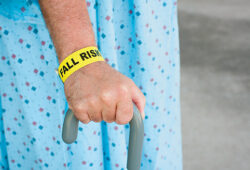Remote-access & portable devices create better care & patient experience
Technology provides us with easier access to information and a quicker way to respond to everything from a work emergency to a personal one—but it can also alert us to life-and-death situations. Here are two notable technological advancements that are changing the landscape of patient care and safety.
Remote health monitoring
Remote health monitoring allows providers to know the “what” before an event or injury happens. Advance alerts are devices that are implanted in patients while they are in the hospital. The technology can then be used after a patient is discharged to guide their care.

William C. Lindsay, M.D., an electrophysiologist with Tennova Medical Group in Knoxville, Tennessee, and a HealthTrust Physician Advisor, says that when a patient goes into heart failure, remote monitoring technology makes it possible for physicians to catch issues earlier while they’re in an outpatient situation. “If you can find them before they start getting into trouble, then you can fix them and the patient can remain an outpatient,” he says.
Dr. Lindsay finds that remote monitoring devices provide useful information to the entire team. “Electrophysiologists have a unique opportunity to help their hemodynamic colleagues, their mutual patients and their hospitals by taking advantage of readily available information, such as the heart failure monitoring metrics in some implantable cardiac defibrillators (ICDs),” he says.
The vast majority of patients who have ICDs implanted have documented heart failure to some degree. Since most newer defibrillators now have heart failure monitoring capabilities, Dr. Lindsay’s process is to notify cardiology counterparts when their patients might be in trouble. “The heart failure monitoring is primarily based on the thoracic impedance measurements, which are plotted over time and are available when the device is checked, either in the clinic or remotely,” says Dr. Lindsay. Other devices can also measure respiratory rate, activity levels and heart rate, among other indicators, which add to the data supporting a heart failure diagnosis.
Dr. Lindsay notes that remote monitoring is also beneficial to hospitals and health systems, since one of Medicare’s areas of focus for penalties is readmission of heart failure patients within 30 days of a hospitalization.

Another example of an advance alert is the cardioMEMS, a remote monitoring system used in some heart failure patients. After patients are discharged, they use a sensor to send biometric readings to a physician’s office for review. “Studies have linked cardioMEMS to a reduction in hospitalizations,” says Karen Bush, MSN, FNP, BC, NCRP, Director of Clinical Research & Education at HealthTrust.
“But it’s important to know that it’s only approved for NYHA class III heart failure patients who were hospitalized for heart failure in the past year, and both the patient and the provider must be engaged.”
Portable CT scanners
In many healthcare settings, such as an ICU, ambulance or trauma center, seconds matter and safety is paramount. Patients in critical care environments often have immediate needs and require many lifesaving interventions. Addressing both time and safety concerns, portable CT scanners can be a critical solution—eliminating the need to move patients and providing diagnostic images immediately for viewing right in the ICU.

“The portable CT scanner offers multiple benefits in the hospital setting,” says Luann Culbreth, MEd, MBA, RT, CRA, FACHE, former Director of Radiology and Cardiovascular Services, Clinical Operations at HealthTrust. “Taking the CT scanner directly to the patient in the ICU, surgery, trauma or other procedural area saves medical professionals from having to move the patient and transfer care.”
Portable scanners are battery-powered and wirelessly connected, with a drive system that enables easy movement through the facility. They use the same technology as traditional CT scanners, although some applications may be limited depending on the type of scanner being used.
These scanners can be used beyond the ICU. “There are other mobile applications for these scanners, such as an ambulance for dedicated stroke programs,” says Culbreth. And, they can be part of a mobile clinic in rural areas.
As for what’s in store, scanners could one day be used in medical helicopter transport—indicating that for these technologies, the sky’s the limit.
Portable CT scanners from Samsung Neurologica are available for contracting as of Feb. 1, 2020.
HealthTrust continues to explore new technologies that enhance care delivery and patient safety. Suppliers with new technology are encouraged to submit products for review year-round. Subject matter experts and service line clinical experts from within the HealthTrust membership will determine whether those products are clinically acceptable, and whether the financial and operational impacts are of such value to add them to the HealthTrust contract portfolio.
Share Email Q1 2020, Remote monitoring





